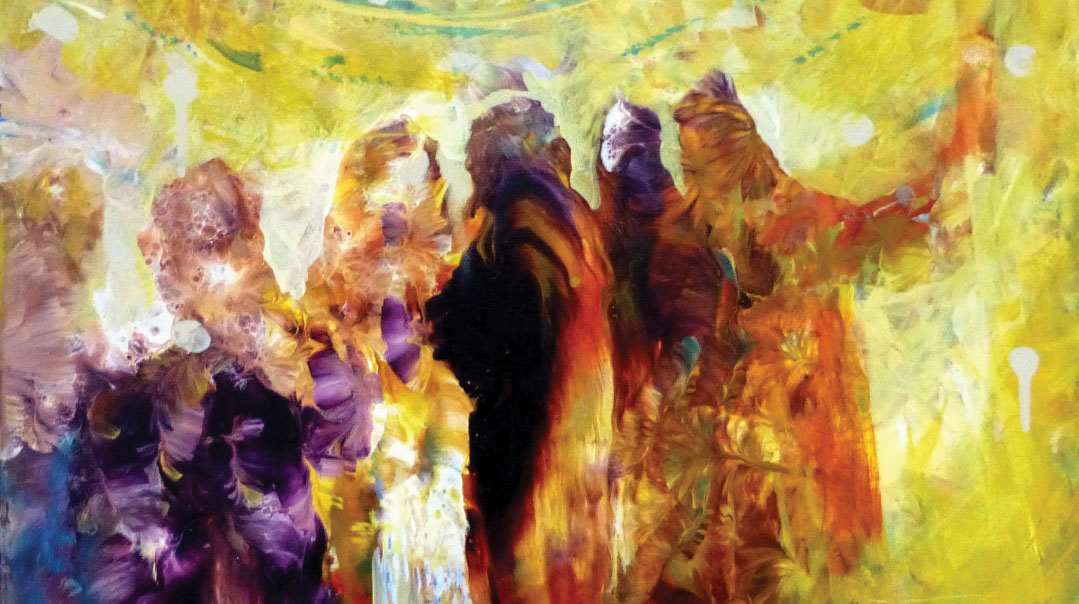Goodness at our Table

Bircas Hatov V’hameitiv
B

The Miracle of Beitar
What comes next in the timeline of our history?
Destruction. Bloodshed. Exile.
Enter the fourth brachah, Bircas Hatov V’hameitiv. The Gemara tells us that this brachah, which begins with the words “Baruch Atah Hashem, haKeil Avinu Malkeinu” and ends with “v’al yechasereinu,” is d’Rabbanan, Rabbinically ordained, unlike the first three brachos, which are Biblically mandated. The sages of Yavneh instituted it after a miracle involving Beitar, the last city in Eretz Yisrael to fall to the Romans, approximately 60 years after Churban Bayis Sheini.
The Rambam (Hilchos Taaniyos 5:3) lists the fall of Beitar as one of five tragic events that occurred on Tishah B’Av. He writes that it was a catastrophe akin to the Churban Beis Hamikdash. The Gemara (Gittin 57a) writes that the number of victims was staggering. For seven years, the gentiles were able to fertilize their vineyards with nothing besides the blood of the Jews slain at Beitar. The flow of blood overturned boulders and streamed for miles into the sea (Yerushalmi Taanis 24b).
But Beitar’s destruction was devastating for another reason as well. It extinguished the last hope for a swift rebuilding of Tzion.
Why would we seek to commemorate a tragedy in our Grace after Meals? Our Sages explain that this brachah, like the others in Bircas Hamazon, gives thanksgiving and praise for Hashem’s goodness. After the fall of Beitar, the Romans added another layer of cruelty: They forbade burial of the victims for years. The wicked emperor Hadrian had a large vineyard, and he constructed a fence around it from the corpses, by standing them upright with their arms spread out.
It was only years later, after Rabban Gamliel and his colleagues fasted, prayed, and bribed the Romans, that permission for burial was granted by a new emperor. A stunning miracle awaited the burial crew. After seven years of exposure, the bodies were still preserved and had not decayed.
In this brachah, we refer to Hashem as HaMelech Hatov V’hameitiv, the King Who is good and Who bestows good. The Gemara (Berachos 48b) explains: Hatov — the Good, Who did not let the bodies decompose and become putrid; Hameitiv — Who bestows good, allowing them to be buried.
We recite a shortened form of this brachah on the specific occasion of shinui yayin, when one enjoys a second, better quality portion of wine. Here, too, we thank for a double dose of goodness.
Why is the isolated miracle of Beitar relevant to Bircas Hamazon? The Avudraham looks at this fourth brachah as a continuation of Bircas Bonei Yerushalayim. The memory of our humiliation and degradation at the hand of our enemies gives poignancy and urgency to our pleas for Geulah.
Yet a deeper look at the miracle reveals that Bircas Hatov V’hameitiv is more than an addendum to the previous brachah. Seridei Eish points out that the halachos of guarding, respecting, and burying the dead are an expression of the promise of techiyas hameisim. Since the guf carried out the will of the neshamah, it deserves a share in its future.
When we secure the body in the ground, it returns to dust, a form of rectification, and then awaits its resurrection, when it will emerge whole and renewed. Thus the discovery of the fresh and intact niftarim at Beitar served as a preview of techiyas hameisim. It’s therefore appropriate that the brachah of Hatov V’hameitiv takes its place among the other brachos of Bircas Hamazon, for, it, too, celebrates — or foreshadows — a momentous chapter in our history.
With Us in Galus
Rav Leib Mintzberg offers another insight into the message of this brachah. The Romans’ intention in forbidding the burial of Beitar’s dead was to heap further scorn on a demoralized and downtrodden people.
Let us imagine the scene when the Jews were finally able to bury their dead and found fresh, whole bodies. The message was startling but clear: You may have been smitten, but you haven’t been abandoned. This message was vital for a nation facing millennia of exile. It was as if Hashem was opening the lengthy, turbulent era of Galus Edom with a declaration of His love for us: My love for you is ahavah she’eino teluyah b’davar —intrinsic, unconditional, and eternal. It doesn’t depend on your merit, status, or location.
The miracle at Beitar was discovered on Tu B’Av, the 15th day of the month of Av. Our Sages cite various reasons that this date is celebrated as a quasi-festival and note, “There were no better days for Yisrael than Yom Kippur and the 15th of Av.” Rav Mintzberg notes that these two special days are grouped together because they share a common theme.
Yom Kippur teaches us that Hashem doesn’t reject a sinner, but accepts his teshuvah and retracts his punishment. Tu B’Av goes one step further, for the event at Beitar demonstrates that Hashem’s love extends even in galus, when He is in the very midst of inflicting a harsh punishment on us. This, the Maharal points out, is the greatest manifestation of Hashem’s goodness.
In a similar vein, Meshech Chochmah writes that while the first three brachos of bentshing trace the development of Klal Yisrael into a nation, the fourth one thanks Hashem for our continued existence, even throughout years of exile. This theme of physical and spiritual survival gives further insight into the practice of reciting Bircas Hatov V’hameitiv on the occasion of shinui yayin.
Wine and galus have a particular relationship, for we are forbidden to drink wine touched by a gentile, in order to prevent assimilation. This halachah, says Meshech Chochmah, often sparks the nations’ animosity, making our survival all the more miraculous.
The Tzelach sees the miracle of the Beitar victims as a symbol for our growth potential in galus. Since it’s the departure of the neshamah that causes the odor and deterioration of a corpse, the miracle signified that the neshamos of the martyrs had not departed, but were still hovering nearby to protect their bodies from rotting. In a similar vein, although we’re in galus, the Shechinah — the neshamah of Klal Yisrael — has not departed from us. Hashem’s Presence may be hidden, but He is very near. Therefore, even in galus, we have the potential for renewal and revitalization.
Earlier in this series, we indicated that the topics of Bircas Hamazon remind us that we eat for a higher purpose. A physical pleasure such as eating can cause us to drift away from Hashem. We need to be reminded that our food energy should be utilized productively, for serving our Master. Thus we make mention in bentshing not only of food, but of mitzvos, Torah, Eretz Yisrael, and other mainstays of spiritual life.
The brachah of Hatov V’hameitiv delivers the same message in a less gentle manner. As the Baal HaTurim puts it, the specter of death reminds us not to squander our lives on food and drink. This gives yet another reason for the recital of Hatov V’hameitiv when drinking a second, better glass of wine. The memory of the Beitar victims is a deterrent to overindulgence.
Even When We Don’t Deserve It
Our brachah serves as the culmination of Bircas Hamazon in a different sense as well. When we consider the tense of each brachah, we note that the first brachah speaks about Hashem in the present tense (He nourishes and sustains all), the second brachah reflects upon the past (You redeemed us from the house of bondage), and the third brachah pleads for the future (Rebuild Yerushalayim, the Holy City).
The words of our fourth brachah wrap up these sentiments by emphasizing that His bestowals of goodness span the past, present, and future. They’re unending, and they’re also constant, for the tov rests even upon the undeserving: He has done good (to the Beitar victims), does good (to us, today), and will do good (in the future, for all time). He has rewarded, does reward, and will reward us forever.
Strikingly, these words echo the words of Bircas Hagomel (the public thanksgiving prayer recited by one who has been saved from catastrophe) and the response of his audience: Blessed is He who grants goodness to the undeserving, who has bestowed upon me all this good. May the One who granted you goodness, continue to give you good, forever.
In Modim of Shemoneh Esreh we refer to Hashem as tov, making the same point about His unceasing goodness: Hatov ki lo chalu rachamav, Hashem is Good, for His compassion is never depleted. There is a Torah source for this definition of tov. In the aftermath of Cheit Ha’eigel, Hashem gives Moshe a greater understanding of His ways (Shemos 33:19): I will pass kol tuvi, all My goodness, before you and I shall be gracious when I desire to be so, and I shall be merciful when I desire to be so (i.e., even if you are undeserving).
The Ramchal in Daas Tevunos famously writes that Hashem is the Tachlis Hatov, the Ultimate Good, and the nature of good is l’heitiv, to bestow good upon others. Since the theme of Bircas Hatov V’hameitiv is tov, its tone is an enthusiastic affirmation of Hashem’s great goodness. We praise Hashem lavishly, using many words.
Since ten is a number that denotes the highest degree, the Maharal writes, we list ten appellations for Hashem: the Almighty, our Father, our King, our Mighty One, our Creator, our Redeemer, our Maker, our Holy One, our Shepherd, the King Who is good and bestows good upon all. The emphasis on the word “our” reassures us that Hashem is with us even in the darkness of galus.
At the same time, the brachah also contains a threefold mention of Hashem’s Kingship: HaMelech Hatov, Avinu Malkeinu, and Melech Ha’olam. Rav Munk points out that this accentuates the basic idea of Bircas Hamazon — that the King of Kings, the absolute ruler of all of mankind, is exquisitely attentive to the needs of all his subjects.
Our brachah goes on to list 15 dimensions and outcomes of this constant goodness: He has brought us relief, salvation, success, blessing, and so on. We then reach the closing words of Bircas Hatov V’hameitiv, which is the closure of the four brachos of Bircas Hamazon (the remainder of bentshing is a collection of prayers for Hashem’s compassion). These last words reference the ultimate form of tov: u’mikol tuv l’olam al yechasereinu. We ask that all the good we receive should never detract from kol tuv — that Hashem’s benevolence, which we so desperately need in This World, should not diminish our portion in the World to Come, the ultimate place of tov.
Sources include the writings of Rav Chaim Friedlander and Rav Moshe Eisemann.
May the inspirations derived from this article serve as an aliyah for the neshamah of my father a”h, Rav Shlomo Leib ben Chaim Yisroel, who was greatly devoted to the mitzvah of Bircas Hamazon.
Mrs. Shani Mendlowitz is menaheles of Bais Yaakov Seminary of Montreal, and a popular lecturer for women.
(Originally featured in Family First, Issue 738)
Oops! We could not locate your form.



